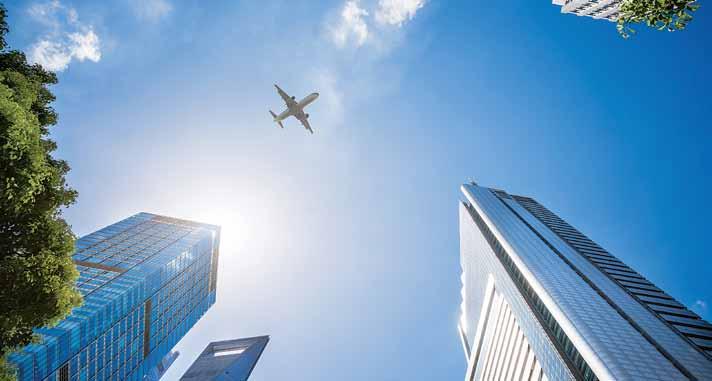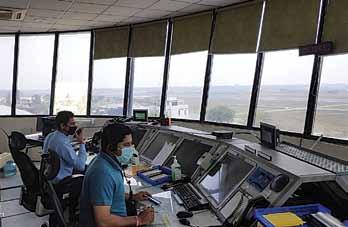
6 minute read
Flight Safety
A mAjor problem expected in the future is the serious shortAge of quAlified And competent mAnpower. solution to this problem would require long term vision And plAnning.
Safety iS Paramount
Over the next 20 years, annual passenger traffic is estimated to grow by 200 per cent which makes it all the more important to sustain enhanced focus on Air Safety
By Air MArshAl B.K. PAndey (retd)
Air Safety is a vital aspect in the domain of civil aviation that needs to be given the highest priority to provide the desired level of safety for the air passengers as also to ensure that airplanes are free from factors that may lead to damage or destruction of the platform. The right level of air safety will also enable the industry to flourish in the long term. Air Safety in civil aviation should not be confused with Security in Civil Aviation as the latter is just one part in the canvas of Air Safety in civil aviation that may also adversely affect safety of the air passengers.
Security in civil aviation includes all of the measures adopted to combat, neutralise or prevent intentional malicious acts by elements that can pose serious threat to the well being of the air traveller. Lapses in aviation security can thus be highly detrimental to the well being of the civil aviation industry as a whole. The focus of this article however, will be on the aspect of Air Safety in civil aviation which will include the state of an aviation system or organisation in which risks associated with aviation activities, related to or in direct support of the operation of aircraft, are reduced and are kept controlled to an acceptable level. Management of Air Safety in the civil aviation industry would include theory, practice, investigation, categorisation of failures experienced in flight and the prevention of such failures through regulation, education and training. It can also be applied in the context of campaigns to promote awareness amongst the travelling public on the issue of safety in air travel. Analysis of data reveals that over the last ten years, 82 per cent of the accidents in the global fleet of jet airliners as well as jet aircraft in the business and general aviation segment
of the civil aviation industry, have taken place during takeoff and landing phase of flight and have accounted for 58 per cent of all onboard and related third party fatalities. Some of the major factors that impinge on Air Safety in the civil aviation industry are elaborated on in the paragraphs below.
ROLE OF HUMAN ERROR
It has been found that the most common cause of accidents in the domain of the civil aviation industry is human error. This factor alone contributes to more incidents and accidents related to aircraft in the domain of the civil aviation industry than any other single factor. Human error would include any error committed by the flight crew, maintenance personnel, air traffic controllers as well as other personnel that will have a direct impact on Air Safety. As per study of the related data, more than 50 per cent of the accidents in this segment of aviation is attributable to error on the part of the pilot in command. Accidents due to human error on the part of personnel other than the pilot in command, is attributable to in only less than ten per cent of the cases of accidents in this category. One type of accident attributable to human error on the part of the pilot in command is dubbed as Controlled Flight Into Terrain (CFIT). Accidents on account of CFIT that are caused by issues related to terrain and conflict with obstacles, has been identified by the International Civil Aviation Organisation (ICAO) to be one of its three categories of high risk occurrence. Another type of accident in this category is Loss of Control In Flight (LOC IF) which takes place on account of loss of situational awareness followed by loss of control of the aircraft during flight at a low speed, low pitch as also high angle of bank.
TECHNICAL FAILURE
There are a number of factors other than human error that contribute to the degradation of Air Safety in the civil aviation industry. One such factor is Technical Failure that could take place in flight by way of loss of power in fight or total engine failure, malfunction of the landing gear or failure of any vital component or system in the aircraft. The adverse effect of such a failure on Air Safety can be aggravated by the inability on the part of the pilot in command or any other member of the flight crew to take the required corrective action in time. Technical Failure is thus one such factor that has been found to impinge on Air Safety in the civil aviation industry and make significant contribution to the overall list of accidents.
RUNWAY SAFETY
Accidents related to Runway Safety figures high in the list of high risk occurrence categories maintained by the ICAO. The Transportation Safety Board (TSB) of Canada, which is officially the Canadian Transportation Accident Investigation and Safety Board, is the primary agency of the Government of Canada that is responsible for ensuring safety of air transportation in Canada. This organisation of the Government of Canada includes runway overruns and unstable approaches on its list of major safety concerns.
High on its list, the TSB has the risk of collision on the runway. Data released by the TSB shows 27 serious runway incursions at the airports in Canada in the period 2011 to 2015. One major concern as revealed by the TSB in its report is that serious runway incursions will continue to occur until better systems and measures are put in place. Similarly, the Australian Transport Safety Bureau has “handling approach to land” high on its list of safety concerns.
BIRD OR ANIMAL STRIKES
Aircraft generally suffer bird strikes on takeoff or during approach and landing. Conflict with terrestrial animals on the ground takes place during the takeoff roll or the landing run. In 2015, the most recent year for which data in this respect is available, there were as many as 13,795 bird and animal strikes reported to the Federal Aviation Administration (FAA) of the United States. While it may be relatively easy to prevent incursion on to the runway by stray animals, preventing bird strikes is a far more difficult task for the airport management.
THE WAY AHEAD
Over the next 20 years, annual passenger traffic is estimated to grow by as much as around 200 per cent which makes it all the more important to sustain enhanced focus on Air Safety in
the civil aviation industry. Rules and regulations have already been promulgated both at the international and national levels, as well as standards have been laid down on Air Safety and security in the domain of the civil aviation industry to protect citizens, goods and property from unlawful interference and accidents. However, the rapid rate of growth, albeit slowed down a bit temporarily due to the COPVID-19 Pandemic, is likely to be restored soon. In the Asia Pacific region, even with the normal growth rate that is expected to be achieved and sustained in the civil aviation industry, it is likely to out pace the ability of regulators to maintain effective oversight, surveillance and the required degree of control expected from the organisation. One problem that plagues the industry today and is expected to be so in the future as well, is the serious shortage of qualified and competent manpower. Solution to this problem would require long term vision and planning. SP

AnAlysis of dAtA reveAls thAt over the lAst ten yeArs, 82 per cent of the Accidents in the globAl fleet of jet Airliners hAve tAken plAce during tAkeoff And lAnding phAse of flight










